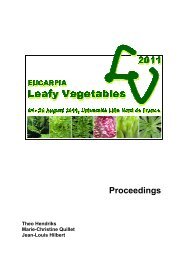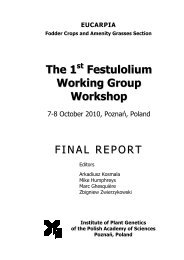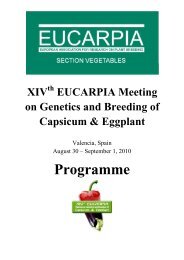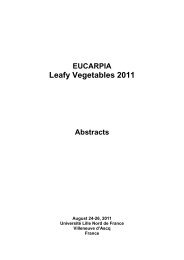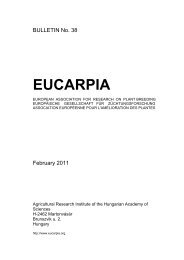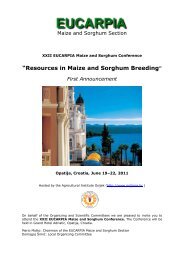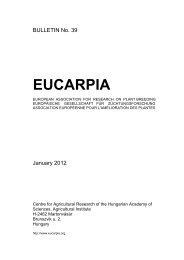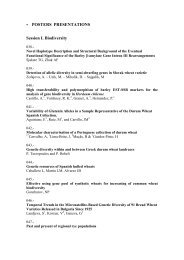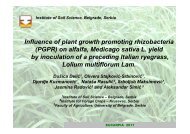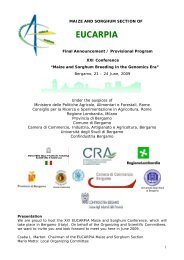Plant breeding for organic and sustainable, low-input agriculture
Plant breeding for organic and sustainable, low-input agriculture
Plant breeding for organic and sustainable, low-input agriculture
Create successful ePaper yourself
Turn your PDF publications into a flip-book with our unique Google optimized e-Paper software.
Additive main effects <strong>and</strong> multiplicative interaction analysis in hulless barley<br />
(Hordeum vulgare L.) genotypes in temperate regions of Iran<br />
Shahram Bahrami 1 , Mohammad Reza Bihamta 2 , Mahboobeh Hosseani 1<br />
1 Zabol University, Zabol, Iran; 2 Tehran University, Tehran, Iran,<br />
Different genotypes show various responses in different conditions (including <strong>low</strong> <strong>and</strong> high-<br />
<strong>input</strong> <strong>agriculture</strong>). There<strong>for</strong>e, there is interaction between genotype <strong>and</strong> environment. There are<br />
several methods <strong>for</strong> determining the genotype environment interaction. Richard et al. (1988)<br />
stated that the Additive Main effect <strong>and</strong> Multiplicative (AMMI) model <strong>for</strong> the yield of g th<br />
genotype in the e th environment <strong>and</strong> with r th replication is as:<br />
Χger= µ+ αg+ βe+Σλnγgnбen+ρge+εger<br />
Vijaykumar et al.(2001) while making use of the AMMI model, in order to determine the<br />
adaptable genotypes in different locations, used the Biplot method. The aim of this research is to<br />
introduce the most stable <strong>and</strong> adaptable genotype(s) <strong>for</strong> each location using AMMI with Biplot<br />
method.<br />
In order to analyze the genotype <strong>and</strong> environment interaction, 20 genotypes were studied in six<br />
locations (Karaj, Esfahan, Neyshaboor, Yazd, Birj<strong>and</strong> <strong>and</strong> Zarghan which Yazd, Birj<strong>and</strong> <strong>and</strong><br />
Zarghan were <strong>low</strong>-<strong>input</strong> factors) <strong>for</strong> two years (2002-2004) in Iran. The data obtained from yield<br />
were examined via Additive Main effect <strong>and</strong> Multiplicative (AMMI) method. Sum of the value<br />
of the IPC scores (SIPC) <strong>and</strong> Eigenvector value (EV) were used <strong>for</strong> determining the stability of<br />
parameters in AMMI method. Also the Biplot method is used <strong>for</strong> recognizing those genotypes<br />
that are adapted to special locations.<br />
The results showed that ICNB93-369, Aleli/4/ mola 3 <strong>and</strong> SB91925 (7) by having the least<br />
interaction in both parameters, were the most stable genotypes which suitable <strong>for</strong> <strong>low</strong>-<strong>input</strong><br />
locations. ICNBF8-653, Condor-BAR/4 <strong>and</strong> EHYTM80-1 with the most interaction in SIPC4<br />
parameter were the least stable genotype <strong>and</strong> ICNB93-328, Condor-BAR/4 <strong>and</strong> Gloria with the<br />
most interaction in EV4 parameter, were the least stable genotypes. Based on Biplot method,<br />
ICNBF8-582, Gloria <strong>and</strong> SB91925 (13) genotypes, were distinguished <strong>for</strong> Karaj location <strong>and</strong><br />
Aleli/4/mola3 <strong>and</strong> SB91488 genotypes were determined <strong>for</strong> Esfahan location.<br />
10




